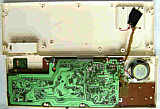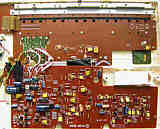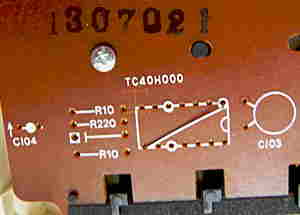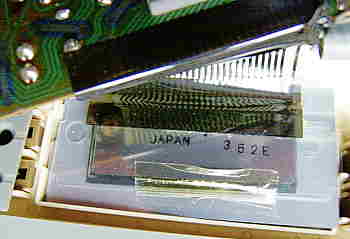|
The instrument has only a monophonic main voice with 4 channel chords, but it features 18 nice rhythms made from analogue percussion with quite special sounding white noise cymbals. There is also an editable sequencer. A dark grey version of this instrument was released as Casio PT-31.
 |
 |
 It would be a hell job to search for matrix eastereggs inside this nasty
hardware design.
It would be a hell job to search for matrix eastereggs inside this nasty
hardware design. |
 |
 On
the PCB there are some empty holes where an additional logic IC was planned. On
the PCB there are some empty holes where an additional logic IC was planned. |
At least with my specimen of PT-30 the speaker has a very unpleasant,
loud mid- range resonance and some keys squeaked badly when pressed (I
lubed them with thick silicone oil to fix them). The hardware of this instrument
consists of 2 stacked, large PCBs with much analogue stuff.  Unfortunately
the SMD CPU sits at the rear side of the control panel PCB, which makes
this instrument extremely awkward to analyse because the buttons and silicone
contacts tend to fall out and the LCD with its fragile plastic foil cable
can easily break or get dusty inside during measurement attempts at the
CPU. (I didn't dare to analyse it further yet, but at least made some PCB
photos.) The CPU is of the same "D1868G" series like in Casio
PT-80, but the following 3 digits are different and it communicates
with an additional small IC "HD B 61914". First I though the small IC would
be an external program ROM and the CPU would be the same. But because my
PT-50
contains also a D1868G series CPU and 2 identical "HD B 61914" ICs, and
the latter are also used in the RAM-Pack RA-1,
I conclude that the 61914 ICs are SRAMs for the sequencer, and the numbers
"001" and "007" at the end of the CPU type "D1868G" instead indicate that
both CPUs contain different software in their internal ROM. Unfortunately
the SMD CPU sits at the rear side of the control panel PCB, which makes
this instrument extremely awkward to analyse because the buttons and silicone
contacts tend to fall out and the LCD with its fragile plastic foil cable
can easily break or get dusty inside during measurement attempts at the
CPU. (I didn't dare to analyse it further yet, but at least made some PCB
photos.) The CPU is of the same "D1868G" series like in Casio
PT-80, but the following 3 digits are different and it communicates
with an additional small IC "HD B 61914". First I though the small IC would
be an external program ROM and the CPU would be the same. But because my
PT-50
contains also a D1868G series CPU and 2 identical "HD B 61914" ICs, and
the latter are also used in the RAM-Pack RA-1,
I conclude that the 61914 ICs are SRAMs for the sequencer, and the numbers
"001" and "007" at the end of the CPU type "D1868G" instead indicate that
both CPUs contain different software in their internal ROM. |
Although the single finger chord section looks interesting, its capability is very restricted; during rhythm the organ chord is always replaced by automatic accompaniment (like with most keyboards) and it is also generally impossible to play fewer or different tones than a standard 3 or 4 note chord, thus this instrument forces the player only to play tone combinations those its programmed musical dogma regards as a chord. A little confusing is also that it ignores further chord type button presses when a chord note key is held, thus you have to also release and press again that key before you can choose another chord type, which is bad for learning by direct comparison how chords sound. But despite all this the PT-30 has some interesting sounds; generally the tones are a bit harsher than my Casio VL-1, and unique is that the "mellow" sound (a sort-of vibraphone) has a vibrato envelope that turns faster while fading silent. The "organ", "violin", "flute" and "horn" all include short sustain and a 6Hz vibrato. "fantasy" is (similar like on VL-1) a high synth flute timbre with longer sustain and 6Hz vibrato (that also turns a tiny bit faster during sustain?). Its a pity that the PT-30 has neither the famous VL-Tone ADSR synthesizer feature nor real polyphonic play. Much like with the VL-1, the "harpsichord" sound suffers from a too slow attack rate, which makes it unrealistic. I also discovered that when shitshot by battery wiggling it sometimes makes other sounds than the built-in presets, much like my VL-1 does.
The analogue rhythms have an interesting timbre with partly long sustaining white noise "cymbals". The toms seem to be based on squarewave tones produced by the main CPU and muffled by external capacitors. But at least my PT-30 specimen has not the strange popping base drum of the technically similar PT-80. The manual organ chord mode plays a sort of thin metal pipe organ rank timbre layered with a warm and dull organ bass and a small dose of sustain. The accompaniment with rhythm simulates a kind of piano and e-bass sound using these waveforms with decay envelope. The 2 "chord change" buttons almost immediately restart the current rhythm pattern on each a different step, which can be used as a sound effect.
The sequencer works quite similar like with Casio VL-Tone 1. To record or edit anything in the sequencer contents, switch the power switch to "record". You can now simply play keyboard (including chords) and everything is recorded. Press "memory play" to listen to it. To change the note lengths, play the melody with the "one key play" buttons in the correct tempo. To delete the last heard note or chord press "del.". Use the arrow buttons "<", ">" to step back and forward (notes and chords sound alternatingly to ease deleting). Any now played notes or chords are inserted at the current position. With the "chord change" buttons you can step the value of a currently displayed chord up and down. To delete the entire song, press "clear". The sequencer supports 8 songs; to switch between songs, press "memory" followed by one of the black keys "M1".."M8". I have no manual for my PT-30, thus there may be still hidden features I don't know. E.g. you can select "edit" here, which in "play" mode simply behaves like an empty memory and in "record" mode mutes the keyboard. The arrow buttons are labelled "save" and "load", which likely refers to the optional TA-1 expansion module to save sequencer data on audio cassettes. Likely you have to set the power switch to "MT", select a song memory and press "save" or "load" to save or load data from cassette.
| Casio TA-1 (tape
storage cartridge for sequencer data)
I now finally got the occasion to buy the very rare Casio TA-1 cartridge ("Tape recorder interface for CASIO electronic keyboard"), originally packaged with manual and connection cable. Unlike my expectation it is not just an empty "pay additional luxury" dongle plug with a few jumper wires or cheap resistors inside to fool customers, but it contains indeed 2 ICs, a clock crystal and some discrete components soldered on 2 small PCBs. The ICs are "HD 43530, 3A13" (44 pin SMD) and "KIKN61S, 2N3111" (10 pin COB).
I don't know if "Kansas City standards" is anything documented or just
a fancy name for a proprietary data format. I also yet haven't tested to
save and load data with it. By my knowledge only the Casio
PT-30 and PT-50 have a cartridge
slot for the TA-1, but possibly also others exist; in the TA-1 manual there
is no list of compatible keyboard types included.
An interesting fact is that Casio first advertised this tape saving feature as "MT" (for "magnetic tape") and later(?) named their entire midsize keyboards series "MT-..." despite none of them included a tape interface. Later Casio named a midsize toy keyboard with built-in stereo cassette player Casio TA-10, which also has no sequencer functions. |
Interesting is also that the Casio PT-30 case has a groove at its upper rim; possibly this style element was inspired by the PlayCard slot of the Yamaha PC-100 to suggest that this keyboard had similar capabilities. The key position dots on the LCD might have been intended as a cheap key lighting replacement, although I could imagine it terribly awkward to use them this way by an expansion module.
A likely direct successor of the PT-30 was the Casio PT-50, which case layout looks almost identical but has a ROM-Pack music cartridge slot (without key lighting) in the upper right corner and the strange case groove is gone. It could not only save sequencer data on cassettes (using the optional TA-1), but even on very obscure RAM- Pack cartridges those look like ROM-Packs but are certainly as rare as the TA-1. In detail there are many small differences between PT-30 and PT-50; e.g. some sounds and especially the entire rhythm set is different.
Also the rare ghettoblaster Fisher SC-300 Stereo Composer likely contained on its top a detachable Casio PT-30 (with different case style resembling Casio PT-50).
 (photo from eBay, showing my specimen)
(photo from eBay, showing my specimen)
This tiny instrument seems to be just a downsized Casio
PT-30
and sounds very similar. (I haven't examined the hardware yet.) Unlike
the latter it is missing the LCD, the cartridge slot, some of the sequencer
buttons, the transpose buttons and 2 high note keys (thus also the "arp.
6" rhythm). Instead of separate rhythm and chord volume sliders it has
only a combined slider. Its small case resembles the Casio
PT-1. The original German retail price in a German Conrad
catalogue from 1986 was 199DM (about 100€).
The likely most advanced member of this hardware family was the ultra-
rare keyboard boombox Casio KX-101
(37 mini keys, chord button pad, complex sequencer that saves data on audio
cassettes), which was even 4 note polyphonic.
| removal of these screws voids warranty... | ||
 |
||
|
|